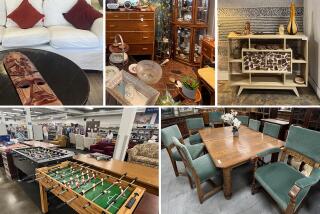Paying for Ill-Gotten Cemetery Pieces
- Share via
Death has always been a part of everyday life. In Victorian times, many children died before they were 10, women died in childbirth, and epidemics such as smallpox often killed several members of the same family. The cemetery was a place to “talk” to the deceased while honoring them with flowers.
Family outings, and often picnics, were commonplace in large, park-like cemeteries. Victorian memorials to the dead included elaborate tombstones, carved statues, cast-iron fences, gates and furniture.
Today we often miss some of the symbolism of the early grave markers. A weeping willow signified grief, and a lamb was often carved on a child’s tomb. A bridal wreath with a dart symbolized a bride; a rosebud with a broken stem was used to remember an infant.
Forget-me-nots, anchors, tree stumps, ivy, doves, crosses, sleeping children and other symbols of death and rebirth are also found on old artifacts from Victorian cemeteries. The park-like cemetery remained popular until about World War I. By that time, many diseases had been conquered and early deaths of family members were less common. The cemetery was rarely visited and sometimes neglected.
The legends of ghosts, goblins and bodies rising from the grave became part of literature and common belief. In the past, attractive carvings and wrought-iron pieces were stolen from cemeteries and sold to collectors. Authorities are now prosecuting those who sell such items, and buyers must return them to the cemetery.
*
Question: I have this strange gadget that was in a drawer in my grandmother’s kitchen. It looks like a short-handled fly swatter. The swatter part is made of loosely woven chain links. What could it be used for?
*
Answer: It sounds like you have an old-fashioned pot cleaner. This type was used from about 1875 to 1915. This was long before scouring pads were made. The 1905 Sears catalog sold the scourer for 8 cents. Collectors of kitchenware will pay about $5 to $10 for one.
*
Q What is a “googly-eyed” doll? My neighbor collects them, but she knows very little about their history.
*
A Googly-eyed dolls were first made in 1911. They were probably meant to mimic the wide-eyed look of Rose O’Neill’s Kewpie illustrations and Grace Drayton’s Campbell Kids ads.
The first googly-eyed dolls had stuffed felt bodies with composition “mask” faces. They were made in Germany and exported by Eisenmann & Co. of Furth, Germany. Samstag & Hilder Bros. of New York City imported the dolls and marketed them as “Hug-Me Kiddies.”
A googly-eyed doll’s big eyes move from side to side and up and down if you shake the doll’s head. Some dolls with all-composition heads have a lever in the back of the head that maneuvers the eyes. Other American importers sold similar dolls and described the eyes as “goo-goo” and “flirting.”
*
Q I bought a blue-and-white dinner plate at an antiques mall. The plate is decorated with roses around the rim. In the middle is a rural scene picturing two boats on a waterway. How old is the plate? Are you familiar with the pattern?
*
A The pattern you describe may be Wild Rose. It was named for the roses around the border. It was used on plates, jugs and many other wares made by various 19th century English potteries between 1830 and 1860. One transfer-printed scene that was used showed a view of Nuneham Courtenay, a famous 18th century garden about five miles southeast of Oxford, England. It included two boats.
*
Q I have an old, white, enameled bucket with a wooden handle. It isn’t as big as a scrub bucket. Can you tell me what it was for and when it was made?
*
A Your enamel bucket is a chamber pail. It was made for toilet use in the bedroom before the days of indoor plumbing. Europeans began experimenting with enamel coatings on metal in the late 18th century. By the mid-1800s, enameled kitchenware and other products were being produced in Europe and the United States.
*
Q I recently paid a lot of money for an antique chair the auctioneer described as a “Martha Washington chair.” He could not tell me how the chair got its name. Can you?
*
A Some chairs, such as the Morris chair, carry the name of their designer. Others, like the Lincoln rocking chair, are named for a famous person who used them. Furniture historians disagree about why and when the Martha Washington chair got its name.
The Sheraton-style armchair has a high, upholstered back, low seat, open arms and delicately turned legs. Some say that John Short, a Salem, Mass., furniture maker, used the term “Martha Washington chair” on labels he used during the 1790s. Others say the chairs were called “lolling chairs” until the Martha Washington name became more generally known in the early 1800s.
Historians do agree, however, that there is no evidence that Mrs. Washington ever owned a chair of this style.
For a listing of helpful books and publications, include a self-addressed, stamped (55 cents) envelope to Kovels, Los Angeles Times, King Features Syndicate, 235 E. 45th St., New York, NY 10017.
Current Prices
Figures are recorded from antique shows, flea markets, sales and auctions throughout the United States. Prices vary in different locations because of local economic conditions.
* Gold Medal Flour cookbook, 1917, $25.
* Adam six-sided hatbox, colored panels of men, $40.
* Franciscan sugar and creamer, El Patio pattern, $55.
* Indianapolis Sanitary Kraut Cutter, three steel blades, patent April 18, 1905, $75.
* Mickey Mouse pocketknife, yellow, World’s Fair Chicago, 1933, $110.
* Western Flyer bicycle, Buzz Bike, 1970s, 20 inches, $200.
* Stanley scrub plane No. 40, rosewood handles, notched logo, circa 1940, $410.
* Red Crown Gas globe, one-piece white milk glass, crown-shaped, red trim, 16 1/2 by 16 inches, $440.
* Beam bottle, Harolds Club, man in barrel, No. 2, 1957, $520.
* Chippendale tilt-top tea table, walnut, tripod base, claw feet, carved knees, pie-crust edge, 26 by 28 inches, $4,000.
More to Read
Sign up for Essential California
The most important California stories and recommendations in your inbox every morning.
You may occasionally receive promotional content from the Los Angeles Times.













